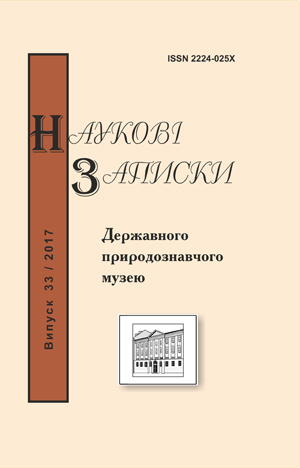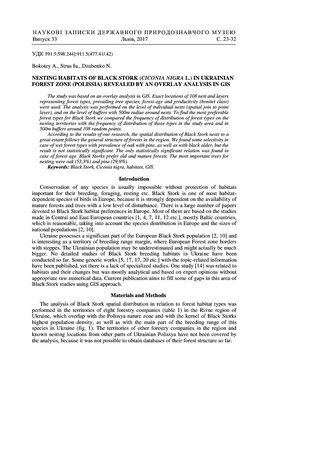Bokotey A., Strus Iu., Dzubenko N. Nesting habitats of Black Stork (Ciconia nigra L.) in Ukrainian forest zone (Polissia) revealed by an overlay analysis in GIS // Proc. of the State Nat. Hist. Mus. - Lviv, 2017. - 33. - P. 23-32.
DOI: https://doi.org/10.36885/nzdpm.2017.33.23-32
Key words: Black Stork, Ciconia nigra, habitats, GIS
The study was based on an overlay analysis in GIS. Exact locations of 108 nest and layers
representing forest types, prevailing tree species, forest age and productivity (bonitet class)
were used. The analysis was performed on the level of individual nests (spatial join to point
layer), and on the level of buffers with 500m radius around nests. To find the most preferable
forest types for Black Stork we compared the frequency of distribution of forest types on the
nesting territories with the frequency of distribution of those types in the study area and in
500m buffers around 108 random points.
According to the results of our research, the spatial distribution of Black Stork nests to a
great extant follows the general structure of forests in the region. We found some selectivity in
case of wet forest types with prevalence of oak with pine, as well as with black alder, but the
result is not statistically significant. The only statistically significant relation was found in
case of forest age. Black Storks prefer old and mature forests. The most important trees for
nesting were oak (53,3%) and pine (29,9%).
References
- Augutis D., Stanislovas S. Application of geographic information system (GIS) technologies in identification of potential nesting habitats of black stork (Ciconia nigra) // Acta Zoologica Lituanica, 15(1). – 2005. – P. 3-12.
- Birds in Europe: population estimates, trends and conservation status. – Cambridge, UK: BirdLife International. – 2004. – P. 107-132.
- Cieslak M. Gniazda bociana czarnego (Ciconia nigra) w Lasach Janowskich, Woj. Tarnobrzeskie // Notatki Ornitologiczne. – 1988. – T. 29, z. 3-4. – S. 227-231.
- Drobelis E., Matiukas G., Vaticus G. Juoduju gandru apskaita Lietuvoje 1995 // Ciconia, 4. – P. 16-21.
- Klestov N.L. The Black Stork in the Maloye Polesye: number, territorial distribution and biotopes // 1st Intern. Black Stork Conserv. and Ecol. Symposium. Program. Abstracts. Participants. Jurmala 19-23 Apr. – 1993. – P. 52.
- Lõhmus A., Sellis U., Rosenvald R. Have recent changes in forest structure reduced the Estonian black stork Ciconia nigra population? // Biodiversity and conservation, 14. – 2005. – P. 1421 -1432.
- Rosenvald R., Lohmus A. Nesting of the black stork (Ciconia nigra) and white-tailed eagle (Haliaeetus albicilla) in relation to forest management // Forest Ecology and Management, 185. – 2003. – P. 217-223
- Skuja S., Budrys R.R. Nesting sites of Black Stork, Lesser Spotted Eagle and Common Buzzard and their nest exchange in the forest of North-East and Central Lithuania // Baltic Forestry, 2. – 1999. – P. 67-74.
- Tamas E.A., Kalocsa B. An analysis of nesting data of Black Storks Ciconia nigra in the Gemenc region of the Danube-Drava National Park (1992-2003) // Biota. – 2006. – Vol. 7, 1-2. – P. 47-50.
- The EBCC Atlas of European Breeding Birds: Their Distribution and Abundance / Edited by Hagemeijer E. J. M., Blair M. J. T & A D Poyser. – London, 1997. – Р. 47-50.
- Treinys R., Lõhmus A., Stončius D., Skuja S., Drobelis E., Šablevičius B., Rumbutis S., Dementavičius D., Naruševičius V., Petraška A., Augutis, D. At the border of ecological change: status and nest sites of the Lithuanian Black Stork Ciconia nigra population 2000- 2006 versus 1976-1992 // Journal of Ornithology. – 2008. – 149 (1). – P. 75-81.
- Treinys R., Stončius D., Augutis D., Skuja S. Breeding habitat of the Black Stork Ciconia nigra in Lithuania: Implications for conservation planning // Baltic Forestry. – 2009. – 15 (1). – P. 33-40.
- Tsachalidis E.P., Poirazidis K. Nesting habitat selection of the black stork (Ciconia nigra) in Dadia National Park, northeastern Greece // Sustainable Management and Development of Mountainous and Island Areas. – 2006. – P. 147-453.
- Bumar H., Horban I. Biolohiia hnizduvannia chornoho leleky Ciconia nigra L. na Polissi // Visn. Lviv. un-tu. Ser. Biol. 37. – 2004. – C. 159-168. [In Ukrainian]
- Ivanovskii V.V. Sovremennoe sostoianie chernogo aista Ciconia nigra v Belorusskom poozere // Rus. ornit. zhurn. – T. 24. – 2015. – S. 3673-3683. [In Russian]
- Panchuk O.S., Serebriakov V.V. Suchasnyi stan chyselnosti ta deiaki osoblyvosti biolohii chornoho leleky v zakhidnii chastyni Zhytomyrskoho Polissia // Zapov. sprava v Ukraini.– 2010. – 16 (1). – C. 55-60. [In Ukrainian]
- Panchuk O., Serebriakov V. Chornyi leleka Ciconia nigra L. v Zakhidnomu Polissi // Visn. Lviv. un-tu. Ser. Biol. 54. – 2010.– S. 194-202. [In Ukrainian]
- Pogrebniak P.S. Osnovy lesnoi tipologii. 2-e izd. ispr. i dop. – Kiev: Izd-vo AN USSR. –1955. – 456 s. [In Russian]
- Romanov M.S., Evstigneev O.I. Mestoobitaniia khishchnykh ptitc i chernogo aista v sviazi s prostranstvennoi strukturoi lesnogo pokrova // Russian Journal of Ecosystem Ecology.– 2016. – Vol. 1 (3). – 20 p. – DOI 10.21685/2500-0578-2016-3-5. [In Russian]
- Shkaran V.I. Rasprostranenie i nekotorye osobennosti ekologii chernogo aista na severe i severo-vostoke Volynskoi oblasti. – Aisty: rasprostranenie, ekologiia, okhrana. Minsk: Navuka i tekhnika. – 1992. – S. 204-206. [In Russian]


